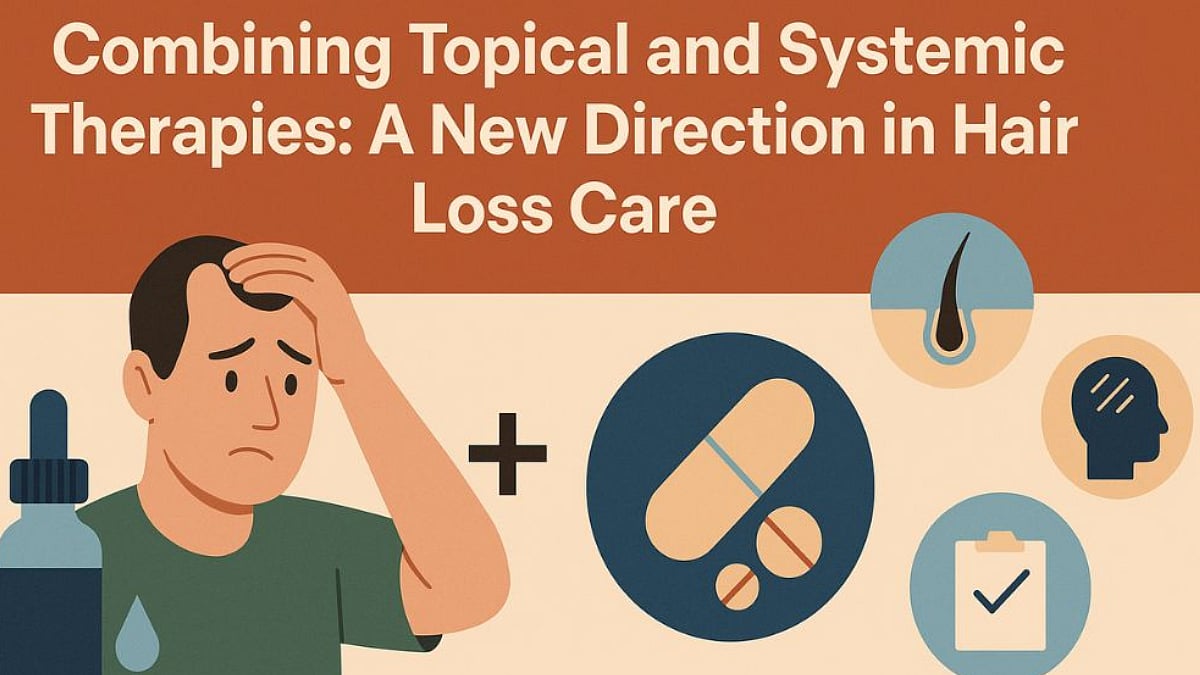Combining Topical And Systemic Therapies: A New Direction In Hair Loss Care
Hair loss affects millions worldwide, but nowhere is the impact felt more acutely than in urban India, where young men and women increasingly report thinning hair in their 20s and 30s. Traditionally, the focus has been on topical agents such as minoxidil, applied directly to the scalp.

Rethinking Hair Loss | File Photo
New Delhi [India], October 6: Hair loss affects millions worldwide, but nowhere is the impact felt more acutely than in urban India, where young men and women increasingly report thinning hair in their 20s and 30s. Traditionally, the focus has been on topical agents such as minoxidil, applied directly to the scalp. While these treatments have provided relief to many, they often fall short of expectations.
A growing body of research now suggests that the next wave of progress may not come from a new “miracle drug,” but from a more integrated approach: combining topical therapies with systemic interventions that address the root causes of hair loss.
Why Topical Treatments Alone Aren’t Enough
Topical treatments like minoxidil work by improving circulation and extending the growth phase of hair follicles. They are simple, accessible, and backed by decades of use. Yet their limitations are becoming increasingly clear:
. Nutritional gaps remain unaddressed. Deficiencies in iron, vitamin D, zinc, or protein can weaken hair regardless of scalp treatment.
. Inflammation and dandruff persist. Many patients have underlying scalp conditions that topical minoxidil alone does not correct.
. Stress and hormones play a role. Chronic stress, poor sleep, and hormonal fluctuations are powerful contributors to hair loss, yet remain outside the scope of topical agents.
In short, minoxidil treats the symptom, but not the multiple root causes.
The Promise of Systemic Therapies
Systemic therapies address the internal environment in which hair grows. These include:
. Nutritional supplementation for micronutrients and proteins is critical to follicle health.
. Ayurvedic botanicals and adaptogens with anti-inflammatory or hormone-balancing properties.
. Lifestyle interventions such as improved sleep hygiene, stress management, and reduced exposure to environmental triggers.
By targeting internal imbalances, systemic therapies complement topical agents and create a foundation for more sustainable regrowth.
Clinical Evidence Supporting Combination Approaches
The strongest validation for integrated therapy came in 2025, with a randomized controlled trial published in the International Journal of Research in Dermatology.
. Study design: 135 men with androgenetic alopecia (stages II-IV), treated over six months.
. Groups:
. Group A: Holistic regimen combining Ayurveda-based systemic care with minoxidil.
. Group B: Minoxidil alone.
. Group C: Placebo.
. Measurements: Hair density via TrichoScan®, global photography, and patient questionnaires.
Results:
. The holistic group (A) showed a 3.16× higher increase in hair density than minoxidil alone, and 5.82× higher than placebo.
. Patients in the holistic group also reported greater satisfaction and reduced psychological distress related to hair loss.
This study is significant because it moves the conversation beyond anecdotal claims. It demonstrates, under controlled conditions, that combining topical and systemic therapies can outperform monotherapy.
Why Integration Matters
The human body is complex, and so is hair loss. Combining therapies matters because:
1. Multiple pathways are addressed. Circulation, nutrition, inflammation, and hormones are all managed together.
2. Plateau effects are reduced. Patients using minoxidil alone often stop seeing improvements after a few months. Combination therapies sustain progress.
3. Resilience improves. Even if topical application is interrupted, systemic support can help preserve gains.
4. Patient satisfaction rises. Seeing progress from multiple angles boosts adherence and morale.
Lessons for Patients
For individuals struggling with hair loss, this research highlights several important points:
. Act early. Follicles respond better when intervention begins at the first signs of thinning.
. Don’t rely on a single product. True results often require addressing root causes like diet, stress, and hormonal balance.
. Look for objective tracking. Tools like TrichoScan® and dermatologic imaging provide clearer evidence of improvement than subjective observation alone.
. Commit to consistency. Both topical and systemic regimens need time - at least six months to show their full effect.
A Shift in Industry Practice
This integrative approach is not just an academic idea; it is already influencing how the health-tech and wellness sectors operate. Some platforms are testing combined models that weave together dermatology, nutrition, and Ayurveda into structured regimens.
One example is Traya, which has piloted integrative programs and published peer-reviewed clinical data supporting them. By combining systemic and topical solutions, such platforms are paving the way for more comprehensive care in India’s expanding hair loss market.
Challenges and Next Steps
While the evidence is encouraging, the journey is only beginning:
. Long-term studies are needed to evaluate whether these results hold over years, not just months.
. Women must be included. Much of the current data focuses on men, even though female hair loss is a growing concern.
. Standardization is required. Defining the right blend of systemic and topical interventions remains a work in progress.
. Affordability is key. Integrated regimens can be costlier upfront, though they may prove more cost-effective over time by reducing trial-and-error.
Toward a New Standard of Care
The future of hair loss treatment may not lie in discovering a single “silver bullet” drug. Instead, progress may come from recognizing that hair fall is a multi-cause condition requiring multi-pronged solutions.
Topical agents like minoxidil will remain essential, but when paired with systemic therapies that restore balance from within, outcomes improve dramatically. Clinical research now provides proof, not just promise.
For patients, the message is clear: don’t settle for surface-level fixes when deeper, more effective approaches are emerging. For the industry, it’s an invitation to embrace integration as the new standard of care.
Published on: Monday, October 06, 2025, 03:48 PM ISTRECENT STORIES
-
-
-
-
-